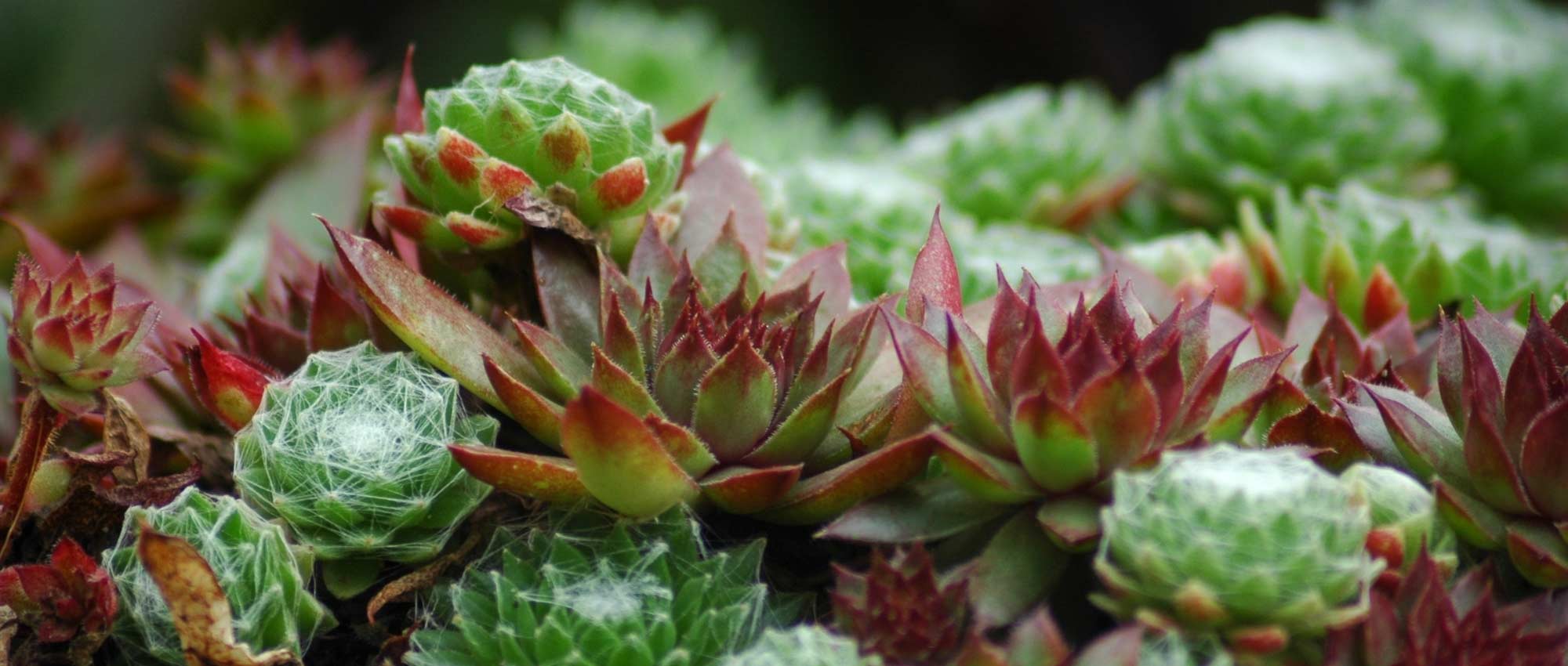
Sempervivum, houseleek: planting, growing and maintaining
Contents
Houseleeks in a nutshell
- Houseleeks are original plants forming beautiful rosettes of fleshy leaves
- They display striking graphic patterns and offer great diversity of colours
- They offer star-shaped flowering, often pink, red, yellow or white
- They are very easy to grow and need no maintenance
- They are undemanding plants requiring very little and able to grow in minimal substrate
- They thrive in well-draining, sunny soil, are very hardy and resistant to drought
A word from our Expert
Houseleeks, or Sempervivum, are small plants native to mountainous regions, forming attractive rosettes of fleshy leaves. They are very low-growing plants, with rosettes sitting at ground level. Among botanical species, Sempervivum tectorum, the roof houseleek, is fairly common in France and has medicinal properties. Sempervivum arachnoideum, the cobweb houseleek, is notable for rosettes bearing fine white threads. But there are also several thousand horticultural varieties, offering a great diversity of shapes and colours! Their leaves can be green, reddish, bronze, purplish, sometimes almost black… Rosettes are evergreen, remaining present throughout the year. Houseleeks also produce attractive star-shaped flowers, often pink, red or yellow.
Houseleeks prefer warm, rocky spots. Place in full sun, ideally between stones in a rockery, or on a wall. Soil must be well drained to avoid stagnant moisture. They tolerate poor soils well. They adapt to a variety of growing media, and are undemanding plants that do not require much soil to grow. They can be planted on a wall, on a roof, in a pot on a windowsill or a balcony… Generally, they look after themselves and need little maintenance! A clump of houseleeks will easily remain in place for years without any care! Houseleeks renew themselves by regularly producing offsets, which makes them very easy to propagate.
Description and botany
Botanical data
- Latin name Sempervivum sp.
- Family Crassulaceae
- Common name Houseleek
- Flowering between June and August
- Height up to 10–15 cm (20 cm maximum during flowering)
- Exposure full sun
- Soil type very free-draining, stony, poor
- Hardiness between –15 and –25 °C
Sempervivum, or houseleeks, are succulent perennial plants that form rosettes made up of fleshy leaves. They are very low-growing, with a cushion-like, spreading habit, the rosettes remaining at soil level. They originate mainly from mountainous regions of southern and central Europe and western Asia. The genus includes about 35 species and is fairly diverse. In addition, many horticultural varieties have been selected for ornamental qualities… more than 3,000 cultivars exist, giving enormous diversity in form and colour. Houseleeks have been cultivated for a very long time. They were once planted on roofs and were reputed to protect against lightning. Sempervivum tectorum is indeed called “roof houseleek”.
In France, seven different species occur in the wild, including Sempervivum arachnoideum, S. montanum, S. calcareum, S. tectorum… they are found mainly in mountainous regions (Alps, Pyrenees, Massif Central…), up to 3,000 metres altitude, in open rocky habitats: rocks, scree, short grass meadows on stony ground, cliffs, stone walls… Sempervivum tectorum also grows on old stone walls. As mountain plants, houseleeks are of course very hardy and can be grown throughout mainland France. In the garden, a rockery is ideal because it most closely matches their natural habitat.
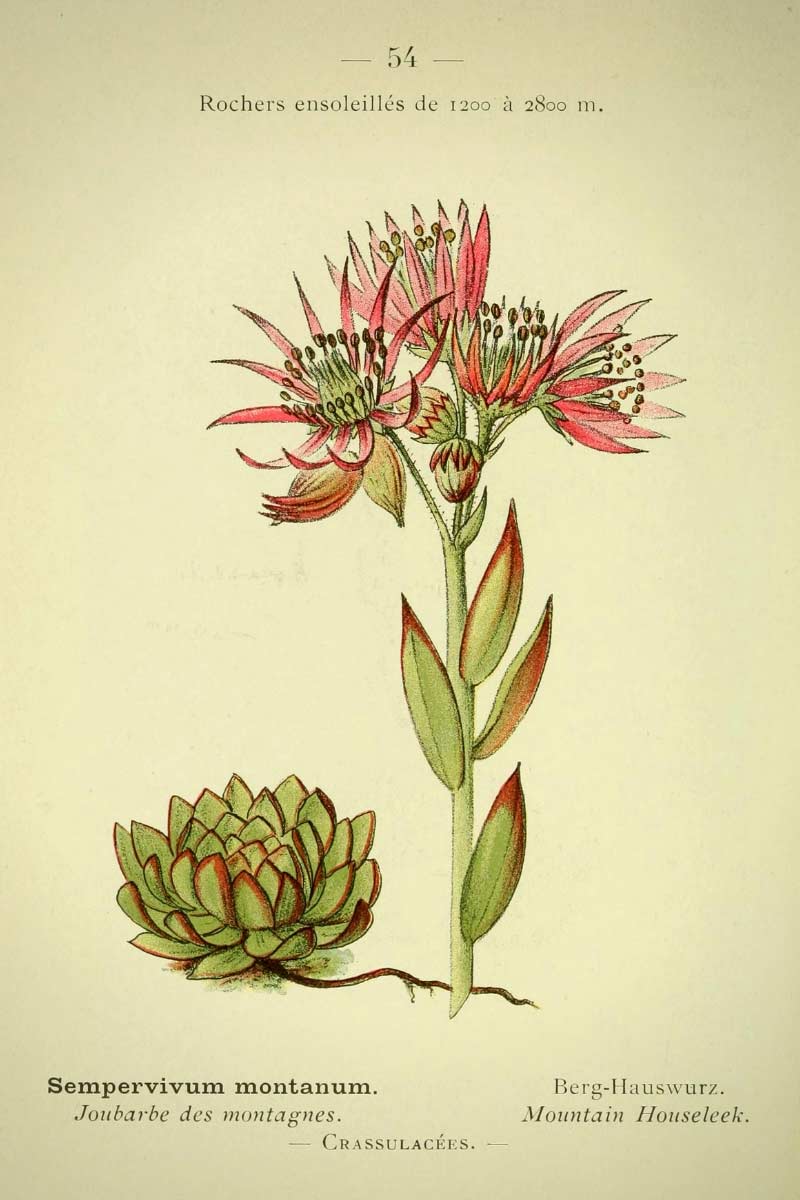
Sempervivum montanum: botanical illustration
Houseleek is a succulent plant (“full of juice”), or fleshy plant, like sedums. It stores water in its tissues to resist drought. This is what gives it a fleshy appearance, linked to its thick leaves. It is truly adapted to life in arid conditions!
Houseleeks belong to large family Crassulaceae, which includes nearly 1,500 species. Sedums, echeverias and kalanchoes are also members of this family. These are mainly succulent plants with fleshy, swollen tissues (leaves, branches or trunk serving as storage organs to hold water and minerals)… Indeed, Crassulaceae comes from Latin crassus, meaning “thick, fat”! These plants are especially suited to very dry environments.
Sempervivum are very close to genus Jovibarba, but their flowers differ in shape (they are campanulate, bell-shaped, in Jovibarba, and star-shaped in Sempervivum). Both genera are commonly called houseleeks. The look of these plants is also similar to that of Aeonium.
The name houseleek comes from Latin Jovis barba, meaning “Jupiter’s beard”, because the plant was reputed to protect houses from lightning, Jupiter’s attribute. Sempervivum comes from Latin semper: always, and vivum: living… referring to these plants’ great resistance to extreme conditions. Also because the rosettes remain present in winter, being persistent. The houseleek remains alive whatever the season or conditions!
The species name S. tectorum means “roof houseleek”. Other names indicate morphology or habitat: S. montanum: “mountain houseleek”; S. arachnoideum: spider-webbed; S. calcareum: chalky houseleek; S. grandiflorum: large-flowered, etc.
Houseleeks are very low-growing, with rosettes at soil level. They can be described as « stemless »: without a noticeable stem (in reality a very reduced stem on which leaves are attached). With their spreading habit, houseleeks follow the contours of rocks or rockeries where they grow. Generally, they measure less than 10 cm in height, although they gain a little height when in flower.
Houseleek rosettes take on the form of a small, flattened, spreading artichoke. Their size usually ranges between 2 and 10 cm in diameter. Ro settes are small in Sempervivum arachnoideum, not exceeding 3 cm in diameter, and much larger in Sempervivum ‘Commander Hay’. The rosettes are semelparous: they flower once and then die… However, each rosette produces offsets that take over and replace it.
Houseleeks produce offsets, new rosettes borne on stolons (above-ground stems). These grow gradually and root where they touch soil. They can be produced at a distance from the parent rosette or very close, attached to it. Offsets allow the plant to spread, forming attractive mats, and to regenerate, since each rosette dies after flowering and is replaced by offsets. Houseleeks can therefore remain in the garden for a very long time because they regularly renew themselves. Individual rosettes have a short lifespan, but an entire clump can live for a very long time. It is very easy to propagate houseleeks by dividing these rosettes.
Houseleek roots penetrate deeply, drawing water and minerals from far below. They anchor the plant well, making it suited to unstable substrates (scree, rockeries…) or places with very little soil. The houseleek “clings” to its support thanks to deep roots capable of slipping into cracks and crevices between stones.
Houseleeks have small fleshy, thick leaves arranged all around a small central stem. The fleshy nature of the leaves allows storage of water and minerals to resist drought, just like cacti and other fleshy plants.
Leaves are inserted in a helicoid fashion, forming a spiral when the rosette is viewed from above. Houseleeks are plants with exceptional graphic appeal, evoking a superb rosette. Generally, leaves are fairly densely arranged (which probably helps reduce water loss through evapotranspiration and better insulate the plant against extreme temperatures). This character is strongly marked in Sempervivum ciliosum, which forms small globular rosettes, very rounded with tightly imbricated leaves. Similarly, rosettes of Sempervivum globiferum take on small spherical forms, very rounded. They are original and amusing.
Houseleeks display great diversity in foliage, both in form and colour. Leaves can be quite narrow and long, or flat and broad. They typically measure between 0.5 and 5 cm in length and may be spatulate, oblong, obovate… They are often tapered to a pointed tip. Leaf shape is surprising in cultivar ‘Grigg Surprise’: elongated, rounded in cross-section, and curved into a “claw” at the tip.
They often take reddish, purplish or bronze shades… Hybridisation has produced thousands of cultivars in a wide range of colours. Rosettes of cultivar ‘Alpha’ are purplish – deep red, contrasted by white cilia highlighting the leaf edge. Rosettes of ‘Chick Charms Gold Nugget’ are striking with fiery orange‑yellow tones. ‘Cherry Berry’ shows a lovely red tone, while ‘Dark Beauty’ is very dark purple, almost black. Generally, leaves often have reddish tips (very visible in Sempervivum calcareum!). Leaves can also be bluish, as in ‘Pacific Blue Ice’, or even yellow: ‘Cmiral’s Yellow’! That latter cultivar is ideal for bringing light and playing with colour, for example paired with sedums of various hues.
Sometimes a single rosette shows several tones: Sempervivum tectorum ‘Sunset’, for instance, offers a superb red and pale green (almost yellow) contrast. In some cultivars only the tip and margin of the leaf are coloured red or black, which beautifully highlights the spiral shape.
Houseleeks tend to change colour with seasons, temperature and sun exposure, varying from green to red, bronze or purple depending on species.

Rosettes of houseleeks can take varied hues: Sempervivum ‘Othello’, Sempervivum ciliosum var. borisii (photo Stephen Boisvert), and Sempervivum calcareum
In Sempervivum arachnoideum, the rosette centre is covered with many fine white threads resembling a spider’s web… hence its name. Similarly, in Sempervivum ‘Boule de Neige’ rosettes become white balls covered with fine white hairs. These houseleeks have a very soft appearance. Sometimes leaf margins are ciliate, giving a superb frosted effect. Hairs glint in sunlight. Leaves can be glaucous, as in Sempervivum ‘Othello’.
Rosettes of houseleeks are, of course, persistent. They remain visible throughout the year, summer and winter alike!
Houseleeks take several years, often between two and four, to flower. Flowering generally occurs in early to mid-summer (between June and August), on rosettes that are already two to four years old. A flowering stem then develops, which can reach up to 20 cm in height. It truly appears as an extension of the rosette, suddenly growing upwards. The flowering stem is covered in leaves (or scales) similar to those of the rosette. It is somewhat branched at the top, where flowers are grouped in a paniculate cyme.
Houseleeks bear handsome star-shaped flowers, quite distinctive. They have a refined, delicate appearance with many floral parts. Flowers often have between 8 and 15 petals, and usually an even greater number of stamens. Petals are fairly thin and radiating, creating a star shape. They surround a ring of stamens arranged circularly. Flowers are hermaphrodite, bearing both male and female organs. However, stamens open before the pistil, which helps avoid self-fertilization.
Flowers are generally pink, red or yellow… often in muted shades rather than bright colours, for example pale pink tending to brown, pale yellow, pinkish white or greenish… Sempervivum arachnoideum has lovely pink flowers, Sempervivum ciliosum bears yellow ones… Petals often show a darker central stripe, adding detail and contrast to the flower.
Generally, stamen colour harmonises nicely with petal colour. Stamens are often darker, with a slightly more intense hue, drawing the eye to the flower centre. They are red in Sempervivum montanum.

Flowering of houseleeks: Sempervivum tectorum ‘Metallicum Giganteum’ (photo H. Zell), pollination of a houseleek flower, and Sempervivum grandiflorum (photo Stan Shebs)
After flowering, houseleeks produce follicles, dry fruits that open when ripe to release numerous tiny brown seeds. It is possible to collect and sow them, but propagation is far easier by division. As rosettes are semelparous, they die after setting seed.
Despite their fleshy appearance, houseleeks are very hardy and can be grown even in fairly cold regions, for example in mountainous areas.
Read also
Decor idea: plants in unusual containersMain varieties of Sempervivum
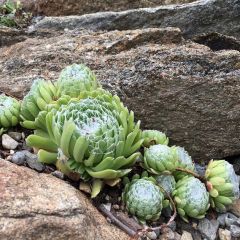
Sempervivum arachnoideum
- Flowering time July, August
- Height at maturity 8 cm
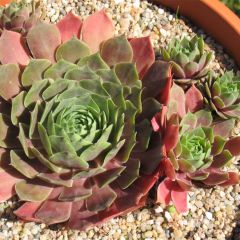
Sempervivum Othello
- Flowering time July to September
- Height at maturity 10 cm
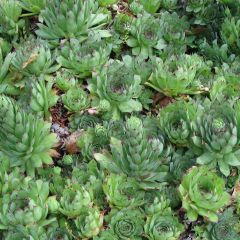
Sempervivum tectorum
- Flowering time July, August
- Height at maturity 10 cm
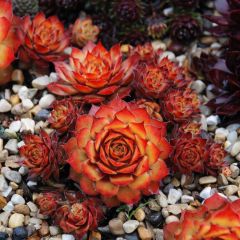
Sempervivum Chick Charms Gold Nugget
- Flowering time July to September
- Height at maturity 10 cm
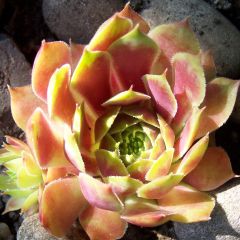
Sempervivum Commander Hay
- Flowering time July, August
- Height at maturity 10 cm
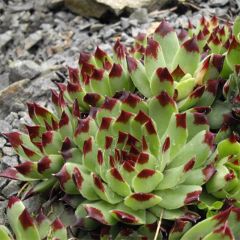
Sempervivum calcareum
- Flowering time July, August
- Height at maturity 10 cm
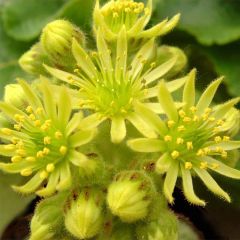
Sempervivum ciliosum var. borisii
- Flowering time July, August
- Height at maturity 10 cm
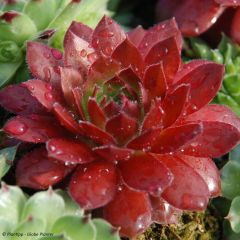
Sempervivum Chick Charms Cherry Berry
- Flowering time July to September
- Height at maturity 8 cm
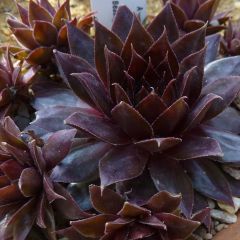
Sempervivum Dark Beauty
- Flowering time July to September
- Height at maturity 10 cm
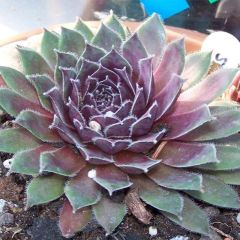
Sempervivum marmoreum Pilatus
- Flowering time July to September
- Height at maturity 10 cm
Discover other Sempervivum - Houseleek
View all →Available in 0 sizes
Available in 1 sizes
Available in 1 sizes
Available in 1 sizes
Available in 1 sizes
Available in 1 sizes
Available in 1 sizes
Available in 1 sizes
Available in 1 sizes
Available in 1 sizes
Planting sempervivums
Where to plant?
Place houseleeks in full sun, as they need plenty of light. However, although fairly resilient and well adapted to drought, houseleeks do not like excessive heat. If you live in Mediterranean region, it is preferable to place them in partial shade for some protection. In other regions, situate them in full sun.
They thrive in rocky or stony, well-draining soils. Avoid substrates that retain water, as these plants dread excess moisture, especially in winter. When to grow them, it is always best to improve drainage by adding gravel or coarse sand at planting time. Do not hesitate to plant on a mound or slope so water can run off easily.
Houseleeks can grow on very poor ground and need very little substrate. Thus, they can be placed on an old stone wall, in crevices… or even on a green roof! They are ideal in a rockery, as that closely resembles their natural medium. It is also possible to create a composition, in a pot or trough, for example with sedums and other small plants. Houseleeks make it possible to green spaces where other plants would struggle. You can easily to grow them even without a garden… a simple windowsill is enough! As they do not need much soil or maintenance, houseleeks can be installed on any type of support or object: in basins, troughs, pottery, suspended in an improvised pot…
As houseleeks are mountain plants, they are very hardy and can be grown even in fairly cold regions, without requiring winter protection. The only precaution concerns excess moisture. If you live in a rainy region, they may need shelter in winter, protected from rain and stagnant humidity… and above all, they will require a well-draining substrate.
When planted in a confined space (pot, crevice, in a rockery between stones), Sempervivum will grow and produce offsets until all available space is occupied. They fill available space well.
Because houseleeks are small plants, to showcase them it is best to place them on a raised bed or in a pot, but at a height above ground level. They will be easier to admire if you put a pot or arrangement on, for example, a table on your terrace, or if you plant them in crevices of a wall, rather than planting them at ground level in a conventional bed.
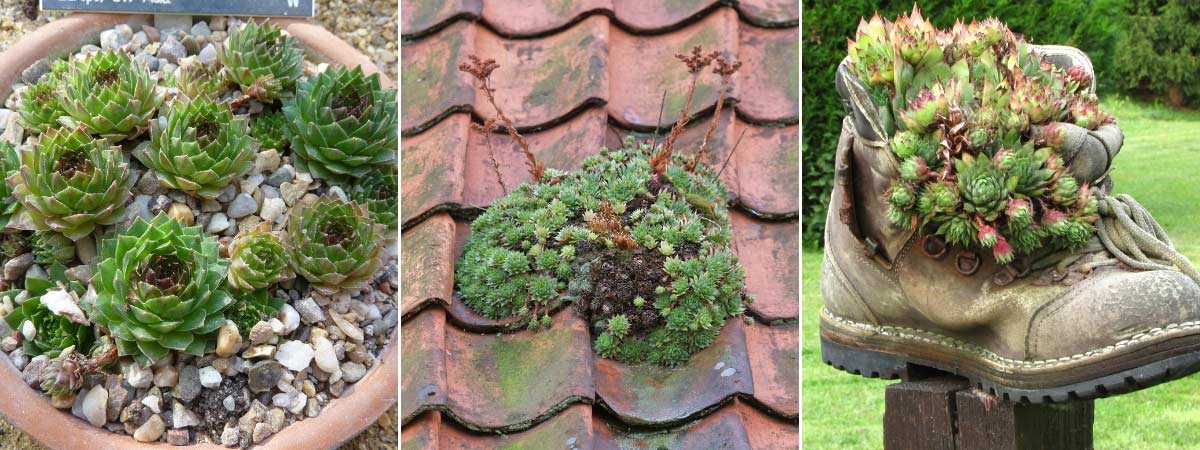
Houseleeks can adapt to very varied situations. They are capable of growing almost anywhere: in a pot (photo Magnus Manske), on a roof (photo Arnoldius), in old shoes or boots… but also on walls, in rockeries, in troughs, or suspended…!
When to plant?
You can plant Sempervivum in spring or autumn, when temperatures are mild. Avoid frosty periods.
How to plant?
For planting in open ground:
- Start by preparing the ground. You can create a rockery by adding stones, gravel… Ideally, we suggest planting on a mound or slope so water can run off rather than pool. In all cases, it is best to mix gravel or coarse sand into planting soil to improve drainage.
- Dig a planting hole, not necessarily very deep.
- Take the houseleek out of its pot and plant it.
- Replace soil around plant.
- You can optionally lay a layer of small gravel on the surface around the rosette, as this prevents water from pooling at the collar while limiting weed growth.
- Water lightly.
Generally, it is not necessary to continue watering; rainwater should be sufficient to meet plant’s modest needs.
→ Also read: How to plant succulents in the ground in the garden?
For planting in a pot:
- Choose a container, preferably with drainage holes, and place a layer of gravel to facilitate water drainage.
- Then add a well-draining substrate, for example a mix of potting compost and coarse sand (a cactus compost can also be suitable).
- Plant your houseleek.
- You can spread a layer of small stones on the pot surface to avoid water stagnating at the collar.
- Place pot in full sun (or partial shade if you live in southern France).
For winter, move it to a spot sheltered from rain.
If planting on a wall, on a roof, between stones, or in another type of container, we recommend creating a small pocket with potting compost so the houseleek has a minimum of substrate in which to establish.
Discover our video tips – Successfully planting alpine perennials in a rockery:
Care
Once established, Sempervivum need almost no maintenance. They are hardy plants, tolerant of both cold and drought. In general, rainwater is sufficient to meet their water needs. However, you can water occasionally during dry spells, but avoid excess moisture. Similarly, Sempervivum do well in poor soil and do not require fertiliser inputs.
You can tidy clumps from time to time, remove faded inflorescences, cut away damaged parts, divide rosettes, and remove material that may cover them: dead leaves in autumn, plant debris, other plants growing nearby… Sempervivum should be kept in full sun. Prune surrounding plants to prevent them shading Sempervivum. Also, as rosettes die after flowering, you can remove those that have dried out. We also recommend dividing them occasionally to rejuvenate and give more room to develop.
Regarding diseases, Sempervivum can be affected by rust (Endophyllum sempervivi), which appears in conditions of stagnant moisture. It is a fungus that parasitises Sempervivum, causing deformation of leaves: they become abnormally elongated, take on a much paler hue, and bear orange pustules. Their appearance therefore changes completely! The pustules contain spores, allowing the fungus to multiply. If you notice this disease, we suggest removing affected rosettes to prevent its spread. You can also treat with a fungicidal product. Also limit watering and improve drainage if necessary.
In any case, the main cultivation problem you may encounter with Sempervivum is excess moisture. It is therefore important to plant them in well-draining soil. Similarly, placing gravel around rosettes prevents water from stagnating there and causing them to rot. And if you live in a rainy area, it is preferable to protect Sempervivum: if grown in a pot, you can easily place it under cover; otherwise, consider installing a small rain shelter. Pubescent, silky varieties are more sensitive than others to winter moisture.
Multiplication
The most commonly used technique is division, because it is easy and quick and reproduces the variety identically, but it is also possible to sow houseleek seeds.
Division
They are very easy to divide! Each houseleek rosette produces new rosettes, right next to the first or attached to a stolon. Simply separate them. Best time is to do this in spring, around April. Ideally wait until the offset has produced some roots and the stolon begins to wither and die back. But they multiply easily even without this.
- Locate a rosette that has produced offsets.
- Separate them by cutting the stolon, close to the original young plant, using a sharp knife.
- Trim the stolon so as to leave about 4 cm under each small rosette taken. Let these rosettes dry for several days (this allows the wound to heal).
- Replant them, in a pot or in the ground, in a well-draining substrate (mix of potting compost and sand).
- Water lightly.
Over time, the rosettes will grow and in turn form new offsets.
Uses and companion planting in the garden
Of course, you can easily plant sempervivums in a rock garden or on a low wall (even on a green roof), with other small plants that tolerate little substrate, are drought-resistant and enjoy full sun. Plant them, for example, with sedums, saxifrages, rockroses, euphorbias (notably Euphorbia myrsinites)… as well as Delosperma, which produces very pretty mauve-pink flowers and fleshy foliage. You can also enjoy small Phlox subulata, which in spring are covered with a multitude of bright, often vivid flowers. In general, we recommend favouring plants with a cushion or mat-forming habit.
Place sempervivums at the front of a rockery, and plant slightly larger specimens behind them, to provide volume: yarrows, lavender, agave, cistus, phormium, phlomis… Avoid planting them too close, so they do not smother or shade each other. Feel free to include some ornamental grasses (Carex comans, blue fescue, Lagurus ovatus…), for the graphic lines and lightness they bring! You can even introduce small rock ferns, such as Cheilanthes lanosa or Asplenium ceterach.
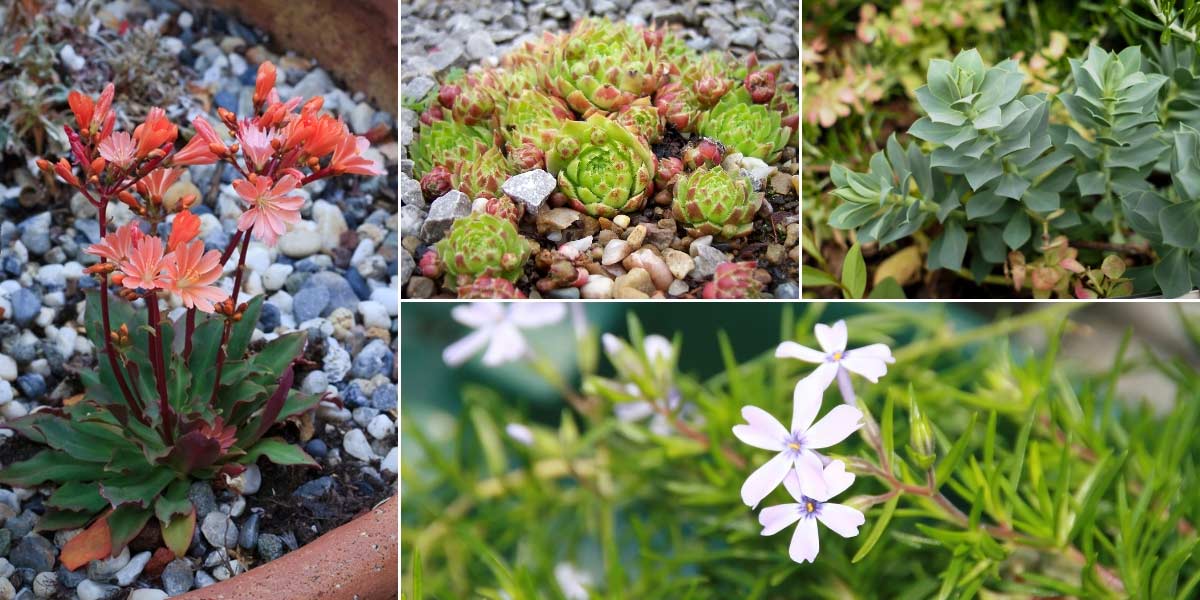
You can certainly plant sempervivums in a rockery, with other plants that appreciate well-drained substrates. Here: Lewisia (photo JKehoe), Sempervivum soboliferum (photo Stephen Boisvert), Euphorbia myrsinites, and Phlox subulata ‘Emerald Cushion Blue’ (photo David J. Stang)
In combination with other small groundcover plants, sempervivums can form a sort of original miniature bed. Take advantage, for example, of Acaenas, and Azorella trifurcata! These are delightful small-leaved plants that will nicely cover the soil around the sempervivums.
To add colour, choose plants with small, delicate flowers: carnations, aubrieta, pansies, Campanula muralis… Also discover Antennaria dioica, which bears charming small flowers in soft hues. Sempervivum also pairs very well with Lewisia cotyledon, which, like it, forms low, evergreen rosettes and produces splendid star-shaped flowers, often pink or orange.
Sempervivums also go well with navelwort, which generally grows spontaneously on rocks and walls.
Sedums and sempervivums make a wonderful combination, as both are small, hardy, fleshy plants with the same cultural requirements, offering a genuine diversity of forms and colours that change through the seasons. Sedums can be yellow, bluish, green, reddish… They are very easy to pair with sempervivums, in pots or rockeries, to create an original little scene! We recommend, for example, Sedum ‘Angelina’, which provides a superb, very luminous yellow and will bring contrast alongside darker sempervivums.
Use sempervivums to create a rockery of alpine plants, gathering species you might naturally find in the mountains. Include, for example, gentians, saxifrages, Arenaria montana, edelweiss, lewisia, androsaces…
If you live in a mild climate where frost is rare, you can pair them with kalanchoes, cacti, euphorbias, opuntias… Favour succulents with fleshy leaves, which will give your bed an attractive exotic look. Also discover the superb Aeonium arboreum and Crassula sarcocaulis, two shrubby, ramified succulents. Enjoy the graphic silhouette of agaves, notably the small Agave victoria-reginae, which has a beautiful white-margined foliage. You can also plant some yuccas. To create this type of exotic bed, choose a warm, sunny spot in well-drained soil, preferably sheltered from the wind.
You can also create a superb container composition, combining different varieties of sempervivums and adding sedums, for example. In a pot, you can place a trailing plant over the rim, such as Dichondra.
Do not hesitate to combine different species and varieties of Sempervivum, to create beautiful effects of form and colour! Let your creativity run free. Sempervivums offer such diversity that the combinations seem endless.
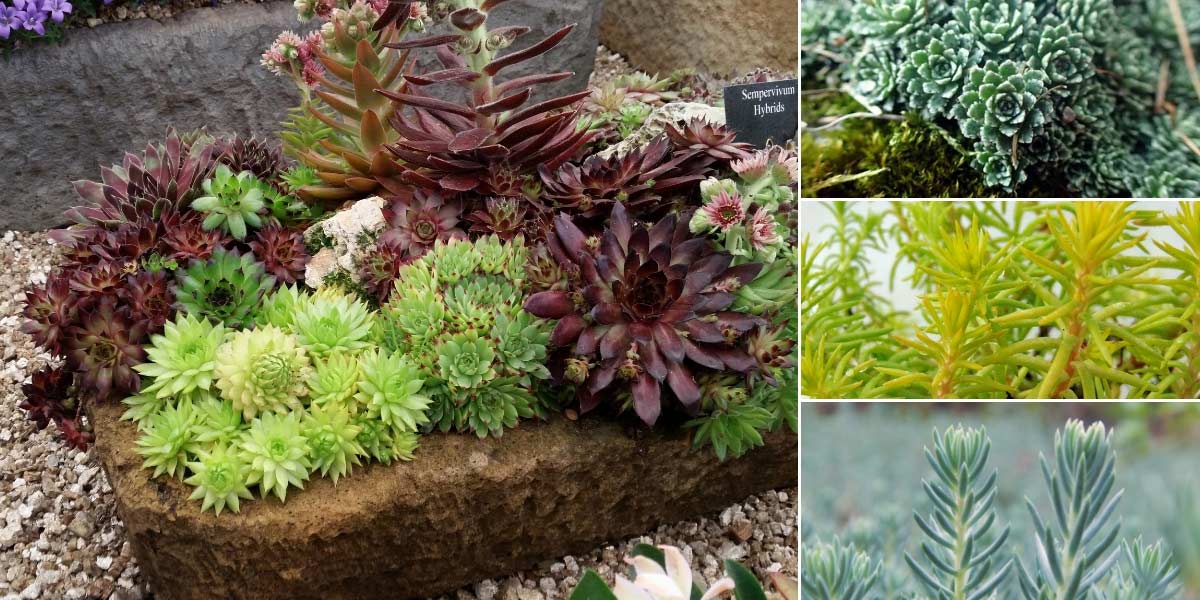
Feel free to combine different varieties of sempervivums, playing with shapes and colours. You can also add saxifrages and sedums. From left to right: Saxifraga paniculata, Sedum reflexum ‘Angelina’, and Sedum reflexum ‘Blue Spruce’ (photo Алина Кучерява)
Did you know?
- Medicinal virtues of joubarbe
Joubarbe Sempervivum tectorum has long been used for its properties. Juice contained in leaves is astringent and aids healing; it is effective against minor cuts, wounds, insect bites, burns… Leaves can be picked and applied directly, fresh, to wounds or inflammations.
Useful resources
- Discover our range of houseleeks
- Our video tips – How to successfully plant alpine perennials in a rockery
- To pair houseleeks in the garden, discover our range of rockery perennials
- An article on Sempervivum and Jovibarba, with lots of information and cultivation advice
- Olivier’s video: Decor ideas with succulents
- Discover Oliver’s video on houseleeks
- Find out more with 5 cacti and succulents that withstand cold and drought!
Frequently asked questions
-
My houseleek has elongated, very pale leaves marked with orange pustules. Why?
It is affected by houseleek rust (Endophyllum sempervivi), a fungus that specifically attacks this plant by parasitising it and is favoured by excess moisture. Leaves then tend to become deformed, taking a surprising, very elongated shape, becoming much larger than usual and acquiring a pale yellowish‑green colour, while bearing circular, yellow‑orange swellings. This disease strikingly alters foliage appearance. We recommend removing affected young plants immediately and not replanting houseleek in the same spot.
-
Rosettes turn brown and appear to rot
This is most likely due to excess moisture, to which houseleeks are very sensitive. Reduce or stop watering; don't hesitate to shelter the plant from rain by bringing it under cover if potted, or by installing, for example, a sheet of glass or plastic above it if planted in the ground. You can also transplant it into a well-draining substrate. However, if you see rosettes becoming damaged and dying after flowering, that's perfectly normal, because they are semelparous: each rosette dies naturally after flowering. They are regularly replaced by offsets.
- Subscribe!
- Contents
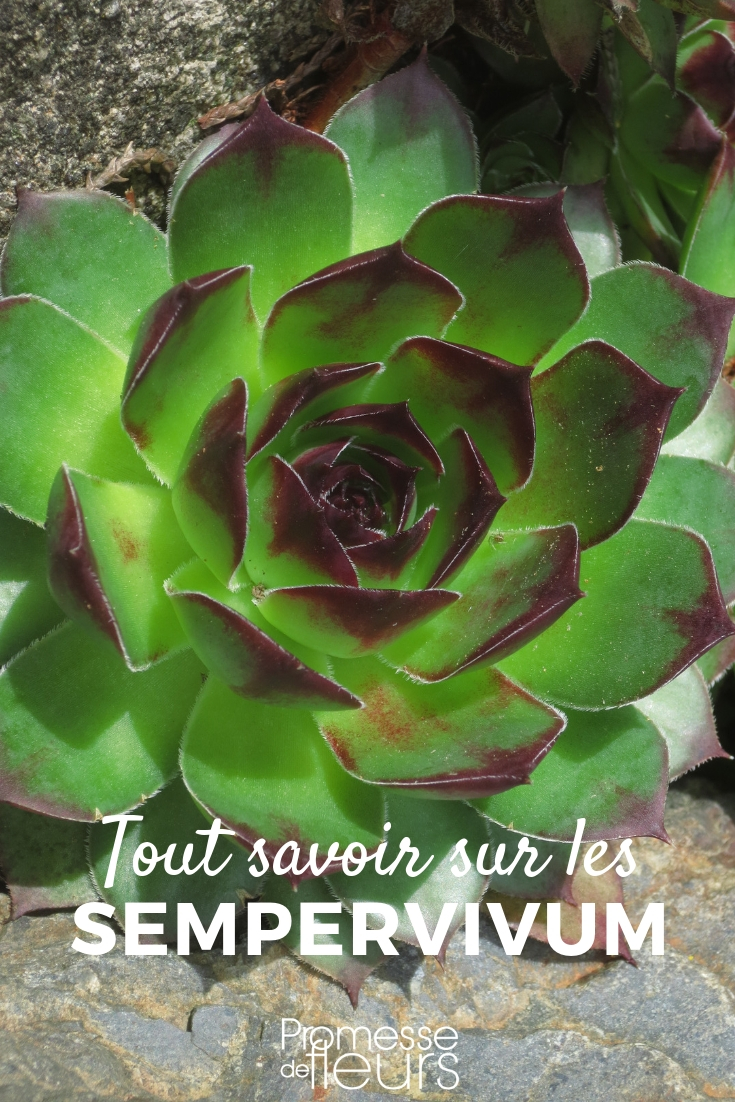































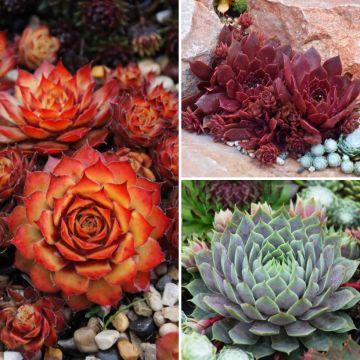

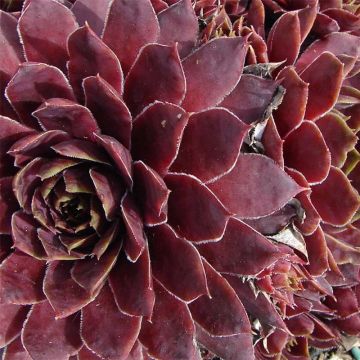
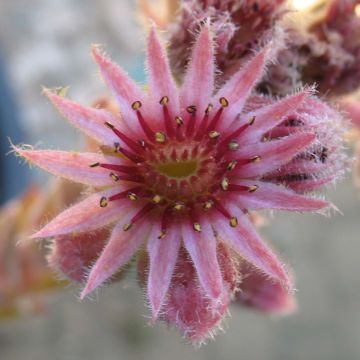

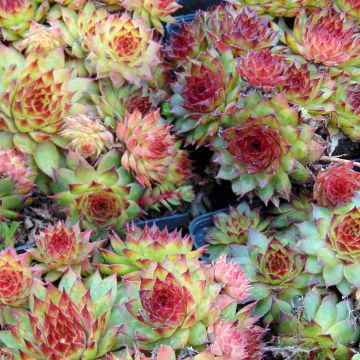


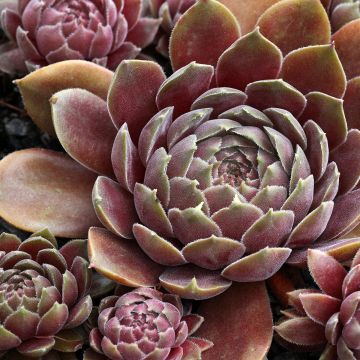

Comments